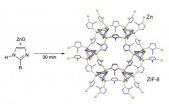(Press-News.org) This press release is available in German.
Abused children are at high risk of anxiety and mood disorders, as traumatic experience induces lasting changes to their gene regulation. Scientists from the Max Planck Institute of Psychiatry in Munich have now documented for the first time that genetic variants of the FKBP5 gene can influence epigenetic alterations in this gene induced by early trauma. In individuals with a genetic predisposition, trauma causes long-term changes in DNA methylation leading to a lasting dysregulation of the stress hormone system. As a result, those affected find themselves less able to cope with stressful situations throughout their lives, frequently leading to depression, post-traumatic stress disorder or anxiety disorders in adulthood. Doctors and scientists hope these discoveries will yield new treatment strategies tailored to individual patients, as well as increased public awareness of the importance of protecting children from trauma and its consequences.
Many human illnesses arise from the interaction of individual genes and environmental influences. Traumatic events, especially in childhood, constitute high risk factors for the emergence of psychiatric illnesses in later life. However, whether early stress actually leads to a psychiatric disorder depends largely on his or her genetic predisposition.
Research Group Leader Elisabeth Binder of the Max Planck Institute of Psychiatry examined the DNA of almost 2000 Afro-Americans who had been repeatedly and severely traumatised as adults or in childhood. One-third of trauma victims had become ill and was now suffering from post-traumatic stress disorder. The risk of developing post-traumatic stress disorder rose with increasing severity of abuse only in the carriers of a specific genetic variant in the FKBP5 gene. FKPB5 determines how effectively the organism can react to stress, and by this regulates the entire stress hormone system. The scientists hoped to cast light on the mechanisms of this gene-environment interaction by comparing modifications of the DNA sequence of victims who had not become ill with that of those who had.
The Munich-based Max Planck scientists were then able to demonstrate that the genetic FKBP5 variant does make a physiological difference to those affected, also in nerve cells. Extreme stress and the associated high concentrations of stress hormones bring about what is called an epigenetic change. A methyl group is broken off the DNA at this point, causing a marked increase in FKBP5 activity. This lasting epigenetic change is generated primarily through childhood traumatisation. Consequently, no disease-related demethylation of the FKBP5 gene was detected in participants who were traumatised in adulthood only.
Torsten Klengel, a scientist at the Max Planck Institute of Psychiatry, explains the findings of the study as follows: "Depending on genetic predisposition, childhood trauma can leave permanent epigenetic marks on the DNA, further de-repressing FKBP5 transcription. The consequence is a permanent dysregulation of the victim's stress hormone system, which can ultimately lead to psychiatric illness. Decisive for victims of childhood abuse, however, is that the stress-induced epigenetic changes can only occur if their DNA has a specific sequence."
This recent study improves our understanding of psychiatric illnesses which arise from the interaction of environmental and genetic factors. The results will help tailor treatment particularly for patients who were exposed to trauma in early childhood, thereby greatly increasing their risk of illness.
INFORMATION:
Original publication:
Torsten Klengel, Divya Mehta, Christoph Anacker, Monika Rex–Haffner, Jens C. Pruessner, Carmine M. Pariante, Thaddeus W.W. Pace, Kristina B. Mercer, Helen S. Mayberg, Bekh Bradley, Charles B. Nemeroff, Florian Holsboer, Christine M. Heim, Kerry J. Ressler, Theo Rein & Elisabeth B. Binder
Allele–specific FKBP5 DNA demethylation: a molecular mediator of gene–childhood trauma interactions
Nature Neuroscience 2012
Childhood trauma leaves mark on DNA of some victims
Gene-environment interaction causes lifelong dysregulation of stress hormones
2012-12-03
ELSE PRESS RELEASES FROM THIS DATE:
A shock to pollution in chemistry
2012-12-03
Solvents are omnipresent in the chemical industry, and are a major environmental and safety concern. Therefore the large interest in mechanochemistry: an energy-efficient alternative that avoids using bulk solvents and uses high-frequency milling to drive reactions. Milling is achieved by the intense impact of steel balls in a rapidly moving jar, which hinders the direct observation of underlying chemistry. Scientists have now for the first time studied a milling reaction in real time, using highly penetrating X-rays to observe the surprisingly rapid transformations as ...
Cell surface transporters exploited for cancer drug delivery
2012-12-03
CAMBRIDGE, Mass. (December 2, 2012) –Whitehead Institute scientists report that certain molecules present in high concentrations on the surfaces of many cancer cells could be exploited to funnel lethal toxic molecules into the malignant cells. In such an approach, the overexpression of specific transporters could be exploited to deliver toxic substances into cancer cells.
Although this finding emerges from the study of a single toxic molecule and the protein that it transports, Whitehead Member David Sabatini says this phenomenon could be leveraged more broadly.
"Our ...
Surprising results from study of non-epileptic seizures
2012-12-03
MAYWOOD, Il. - A Loyola University Medical Center neurologist is reporting surprising results of a study of patients who experience both epileptic and non-epileptic seizures.
Non-epileptic seizures resemble epileptic seizures, but are not accompanied by abnormal electrical discharges. Rather, these seizures are believed to be brought on by psychological stresses.
Dr. Diane Thomas reported that 15.7 percent of hospital patients who experienced non-epileptic seizures also had epileptic seizures during the same hospital stay. Previous studies found the percentage of such ...
A better way to make chemicals?
2012-12-03
Bulk solvents, widely used in the chemical industry, pose a serious threat to human health and the environment. As a result, there is growing interest in avoiding their use by relying on "mechanochemistry" – an energy-efficient alternative that uses high-frequency milling to drive reactions. Because milling involves the intense impact of steel balls in rapidly moving jars, however, the underlying chemistry is difficult to observe.
Now, for the first time, scientists have studied a milling reaction in real time, using highly penetrating X-rays to observe the surprisingly ...
Glowing fish shed light on metabolism
2012-12-03
A tiny, translucent zebrafish that glows green when its liver makes glucose has helped an international team of researchers identify a compound that regulates whole-body metabolism and appears to protect obese mice from signs of metabolic disorders.
Led by scientists at the University of California, San Francisco (UCSF), the work demonstrates how a fish smaller than a grain of rice can help screen for drugs to help control obesity, type 2 diabetes and other metabolic disorders, which affect a rising 34 percent of American adults and are major risk factors for cardiovascular ...
Stanford researchers discover master regulator of skin development
2012-12-03
STANFORD, Calif. — The surface of your skin, called the epidermis, is a complex mixture of many different cell types — each with a very specific job. The production, or differentiation, of such a sophisticated tissue requires an immense amount of coordination at the cellular level, and glitches in the process can have disastrous consequences. Now, researchers at the Stanford University School of Medicine have identified a master regulator of this differentiation process.
"Disorders of epidermal differentiation, from skin cancer to eczema, will affect roughly one-half ...
International study points to inflammation as a cause of plaque buildup in heart vessels
2012-12-03
STANFORD, Calif. — Fifteen new genetic regions associated with coronary artery disease have been identified by a large, international consortium of scientists — including researchers at the Stanford University School of Medicine — taking a significant step forward in understanding the root causes of this deadly disease. The new research brings the total number of validated genetic links with heart disease discovered through genome-wide association studies to 46.
Coronary artery disease is the process by which plaque builds up in the wall of heart vessels, eventually leading ...
Goodbye, fluorescent light bulbs! See your office in a new light
2012-12-03
Say goodbye to that annoying buzz created by overhead fluorescent light bulbs in your office. Scientists at Wake Forest University have developed a flicker-free, shatterproof alternative for large-scale lighting.
The lighting, based on field-induced polymer electroluminescent (FIPEL) technology, also gives off soft, white light – not the yellowish glint from fluorescents or bluish tinge from LEDs.
"People often complain that fluorescent lights bother their eyes, and the hum from the fluorescent tubes irritates anyone sitting at a desk underneath them," said David Carroll, ...
Common diabetes drug may help treat ovarian cancer
2012-12-03
A new study suggests that the common diabetes medication metformin may be considered for use in the prevention or treatment of ovarian cancer. Published early online in CANCER, a peer-reviewed journal of the American Cancer Society, the study found that ovarian cancer patients who took the drug tended to live longer than patients who did not take it.
New treatments are desperately needed for ovarian cancer. Previous research has indicated that metformin, which originates from the French Lilac plant, may have anticancer properties. To look for an effect of the medication ...
Food allergies? Pesticides in tap water might be to blame
2012-12-03
ARLINGTON HEIGHTS, Ill. (December 3, 2012) – Food allergies are on the rise, affecting 15 million Americans. And according to a new study published in the December issue of Annals of Allergy, Asthma and Immunology, the scientific journal of the American College of Allergy, Asthma and Immunology (ACAAI), pesticides and tap water could be partially to blame.
The study reported that high levels of dichlorophenols, a chemical used in pesticides and to chlorinate water, when found in the human body, are associated with food allergies.
"Our research shows that high levels ...
LAST 30 PRESS RELEASES:
Why nail-biting, procrastination and other self-sabotaging behaviors are rooted in survival instincts
Regional variations in mechanical properties of porcine leptomeninges
Artificial empathy in therapy and healthcare: advancements in interpersonal interaction technologies
Why some brains switch gears more efficiently than others
UVA’s Jundong Li wins ICDM’S 2025 Tao Li Award for data mining, machine learning
UVA’s low-power, high-performance computer power player Mircea Stan earns National Academy of Inventors fellowship
Not playing by the rules: USU researcher explores filamentous algae dynamics in rivers
Do our body clocks influence our risk of dementia?
Anthropologists offer new evidence of bipedalism in long-debated fossil discovery
Safer receipt paper from wood
Dosage-sensitive genes suggest no whole-genome duplications in ancestral angiosperm
First ancient human herpesvirus genomes document their deep history with humans
Why Some Bacteria Survive Antibiotics and How to Stop Them - New study reveals that bacteria can survive antibiotic treatment through two fundamentally different “shutdown modes”
UCLA study links scar healing to dangerous placenta condition
CHANGE-seq-BE finds off-target changes in the genome from base editors
The Journal of Nuclear Medicine Ahead-of-Print Tip Sheet: January 2, 2026
Delayed or absent first dose of measles, mumps, and rubella vaccination
Trends in US preterm birth rates by household income and race and ethnicity
Study identifies potential biomarker linked to progression and brain inflammation in multiple sclerosis
Many mothers in Norway do not show up for postnatal check-ups
Researchers want to find out why quick clay is so unstable
Superradiant spins show teamwork at the quantum scale
Cleveland Clinic Research links tumor bacteria to immunotherapy resistance in head and neck cancer
First Editorial of 2026: Resisting AI slop
Joint ground- and space-based observations reveal Saturn-mass rogue planet
Inheritable genetic variant offers protection against blood cancer risk and progression
Pigs settled Pacific islands alongside early human voyagers
A Coral reef’s daily pulse reshapes microbes in surrounding waters
EAST Tokamak experiments exceed plasma density limit, offering new approach to fusion ignition
Groundbreaking discovery reveals Africa’s oldest cremation pyre and complex ritual practices
[Press-News.org] Childhood trauma leaves mark on DNA of some victimsGene-environment interaction causes lifelong dysregulation of stress hormones




